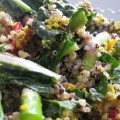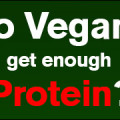
Vegans Have Cleaner Basements
As Vegans, you’ve all been grilled on how you get your protein. Perhaps you’re sick of being asked, but I actually think it’s still a good question. Most people don’t know what to do and even feel paralyzed by the idea of changing their food habits to reflect less reliance on animals. For their entire lives they’ve decided their dinner menu based first on what meat was available and then how to complement it with the right starch and vegetable. This decision-making process is based on successful media propaganda, culture and tradition; all of which are very powerful players. If it’s going to change, then we have to first look at the common myths out there and also see if our own approach to Vegan eating is based on correct information.
Myths and Assumptions About Animal-based Vs. Plant-based Protein
- Children need animal-based protein to ensure proper growth and development.
- A meal is not a REAL one unless it involves meat.
- There is no way you can feel physically satisfied unless you’ve had animal-based protein in a meal.
- The amount of food a Vegan needs to consume is substantially higher in order to get enough protein.
- If you’re not eating animal protein, then you have to rely on soy protein powders, shakes and bars in order to fulfill your daily requirement.
Children: Let’s take a look first at mother’s milk. It has absolutely everything a growing child needs during the period of the most rapid growth and brain development. The average protein concentration in mother’s milk is a comparatively low 1.4%. Most infants are weaned around their first birthday and then oftentimes are switched over to cow’s milk. But while mother’s milk was designed for human children, cow’s milk was designed for calves. It’s not a perfect replacement for mother’s milk as so many assume that it is. We don’t need animal protein per se; we need the amino acids that are inside that protein. There are 21 amino acids that our body needs for optimal physical health, 9 of which we can only get by consuming them. Those 9 amino acids can all be found in plant-based foods.
Is It Still A Real Meal? It takes time and creativity to adjust your thinking here. If you’re new to Veganism, experiment with new recipes, get ideas from other people, go to a Vegan restaurant but more importantly accept a paradigm shift in your thinking because it’s not based on fact.
Meal Satisfaction: To feel satiated after a meal is an interesting concept. It has to do with how your opinion of the taste combined with the circumstances around it. In other words, it’s the difference between eating a meal while enjoying a good conversation and a pleasing ambience and one that takes place in your car between errands. But in terms of physical satisfaction with the food itself it does need to have substance. No one wants to be starving 30 minutes later. Satisfying plant protein sources include quinoa, nut and seed-based butters or other dishes, avocado, potatoes, whole grains, spirulina, smoothies, legumes, fermented soy, etc.
Vegans Need Double The Food. This is perhaps the greatest misunderstanding out there right now since the opposite is actually true. The USDA nutrient database suggests that 1 out of 10 calories consumed should be a protein calorie. That means if you’re an adult female you need roughly 46 grams a day and for males about 56 grams. But if you look at other research conducted around the world, it suggests that 25-35 grams is a better estimate and perhaps even less if that protein is consumed from live foods. The standard American diet has most people eating 50% more protein than they actually need. Here’s a list of some foods and their protein content:
Artichoke Hearts: 1 cup=8 grams
Avocado: 1 medium=4 grams
Black and Adzuki Beans: ½ cup=9 grams
Broccoli: 1 cup=5 grams
Hemp Seeds: 2 tbsp. =5 grams
Spirulina: 1 cup=64.37 grams
Garbanzo Beans (Chickpeas): 1 cup=15 grams
Lentils: ½ cup=10 grams
Baked Potato with Skin: 5 grams
Bok Choy: ½ a head=6 grams
Dates: 1 cup=3.6 grams
Zucchini: 1 medium=4 grams
Sundried Tomatoes: 1 cup=8 grams
So, let’s put a quick meal together using some of these ingredients. Shredded zucchini lightly sautéed in coconut oil then combined with canned chickpeas, sundried tomatoes, fresh garlic, sea salt and pepper. That meal will provide you with about 15-20 grams of protein.
Powders, Shakes and Bars. Yes, they’re convenient but it’s not at all necessary and you stand to overdose on protein by relying on them as meal replacements.
I read an excerpt from a book by Dr. Gabriel Cousins recently which dealt with the health of our bodies at the cellular level. He referred to the Wendt Doctrine, a 30-year research study conducted by a group of German physicians looking at the relationship between protein consumption and degenerative diseases. They found that excess protein clogs the basement membrane, which is a filtering membrane, located between capillaries and cells. This membrane helps regulate the flow of nutrients and waste products between capillaries, cells and fluid in the tissues. The more excess protein there is in the diet the more protein is lodged in the basement membrane. This eventually leads to a clogged membrane and is the start of ill health. They also found that abstaining from animal protein and consuming a plant-based lower protein diet reversed that state.
So if you’re Vegan congratulate yourself and then feel free to tell your friends and co-workers that you have a cleaner basement. I’m sure they’ll get it right away!
by Melissa Sanborn of Nutritional Brands, PureVegan
*A special Thank You goes to Siegren Johnson of Tru Cuisine for providing insight into this issue and for directing my search for resources.
Research Sources
- 1. Understanding Normal and Clinical Nutrition, 5th Edition. Table of Food Composition
- 2. The 80/10/10 Diet by Dr. Douglas N. Graham, pages 102-114 by Food and Sport Press
- 3. Are You Eating Enough Protein-Or Too Much by Dr. Gabriel Cousens, M.D. and excerpt from Spiritual Nutrition, 2005, North Atlantic Books
- 4. Optimal Diets for Prevention of Coronary Heart Disease, JAMA. www.jama.ama-assn.org/content/288/20/2569.short.






2 Comments
Chia (324 comments)
February 28, 2012 at 8:39 pmFunny title. It’s a bit annoying to hear that same ol’ question, “Where you get your protein?” as if protein ONLY comes from the flesh of dead animals and nowhere else. Mostly it’s just a lack of nutrition awareness… Thanks for sharing this!
robinhood (18 comments)
March 12, 2012 at 9:29 amBeing healthier on a vegetarian diet means spending less on health care. Food costs. Vegetarian foods tend to cost less than meat based item.Be vegetarian live more.Have a look of vegan making receipe dvd
http://bit.ly/sumthv